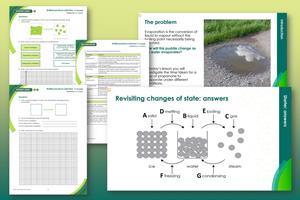Use this class practical to measure and compare the rate of evaporation of propanone under different conditions
-

Download this
A ready-to-go practical lesson with classroom slides, integrated instructions, scaffolded and unscaffolded student worksheets and teacher guidance, including full technical notes and answers to all questions.
Discover more resources from the Nuffield practical collection
Evaporation is the conversion of liquid to vapour without the boiling point necessarily being reached. In this experiment, learners measure and compare the time taken for a drop of propanone to evaporate under a number of different conditions.
Propanone is highly flammable – ensure that there are no sources of ignition nearby. Learners could be asked to devise their own experiment, in which case teachers must check the plans before practical work starts, or they could be told how to vary the conditions and exactly what to do. See the sample results table from the student sheet available for download below.
Learning objectives
- Carry out an investigation into the rate of evaporation of propanone.
- Make and record observations.
- Use particle theory to explain your results.
Scaffolding
There are two versions of the student worksheet.
The scaffolded sheet (✪) offers more support including a ready drawn results table and a bar chart with labelled axes. Teachers may decide that different groups should use different experimental conditions and then pool the results or limit the number of conditions used in the investigation.
The unscaffolded sheet (✪✪) offers the opportunity for learners to make their own decisions about which conditions to use in the investigation and how to present their results. The additional questions are unscaffolded.
Technician notes
Read our standard health and safety guidance and carry out a risk assessment before running any live practical.
Apparatus
- Eye protection: safety glasses to EN166F
- Microscope slides, x 2 or 3
- Warm water
- Dropper pipette
- Timer
Chemicals
- Propanone (acetone), C3H6O(l) (DANGER: highly flammable, irritant) – a few cm3
- Highly flammable liquid and vapour
- Causes serious eye irritation
- May cause drowsiness or dizziness
- Repeated exposure may cause skin dryness and cracking
See CLEAPSS Hazcard HC085a. In Scotland, refer to SSERC for safety advice.
Preparation
Dispense in a small bottle/container with a screw top and only give out a small amount. Label the bottle with the name of the chemical and the hazard signs/warnings.
Safety and hazards
- Propanone is highly flammable – ensure that there are no sources of ignition nearby.
- Check that the microscope slides are undamaged and that they do not have sharp edges.
- Keep the bottles of propanone closed when not in use to avoid evaporation.
- Review the risk assessment for your chosen method to warm and cool the microscope slides.
- The microscope slides can be rinsed and dried after use.
Method
- Before you start, predict which conditions will lead to:
- the fastest rate of evaporation.
- the slowest rate of evaporation.
- Put a drop of propanone onto a microscope slide and time how long it takes to evaporate.
- Change the conditions according to the next row in the results table, repeat the experiment and record the time taken for each one.
Teaching notes
Learners should be able to observe that warmth, air flow and spreading out the drop all increase the rate it evaporates. The questions included on the student worksheets explore each variable.
Liquids evaporate below their boiling point. This is because as the particles move around and collide, some have more energy than the others allowing them to escape from the rest of the liquid as vapour. This results in the overall energy of the liquid (and therefore its temperature) decreasing.
This experiment lends itself well to being a planning exercise or alternatively there are some sample results tables available.
Downloads
Rate of evaporation student scaffolded
Handout | PDF, Size 1.16 mbRate of evaporation student unscaffolded
Handout | PDF, Size 1.66 mbRate of evaporation presentation slides
Handout | PDF, Size 1.9 mbRate of evaporation teacher notes
Handout | PDF, Size 0.27 mbRate of evaporation student scaffolded
Editable handout | Word, Size 1.06 mbRate of evaporation student unscaffolded
Editable handout | Word, Size 2.88 mbRate of evaporation presentation slides
Editable handout | PowerPoint, Size 3.18 mbRate of evaporation teacher notes
Editable handout | Word, Size 0.49 mb
Additional information
This is a resource from the Practical Chemistry project, developed by the Nuffield Foundation and the Royal Society of Chemistry. The supporting resources were updated in 2025 by Dorothy Warren.
Practical Chemistry activities accompany Practical Physics and Practical Biology.
© Nuffield Foundation and the Royal Society of Chemistry

































No comments yet